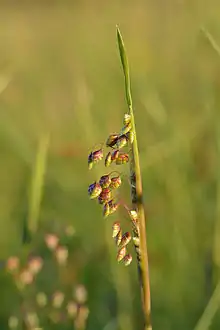Briza media
Briza media is a perennial grass in the family Poaceae and is a species of the genus Briza.
| Briza media | |
|---|---|
 | |
| Scientific classification | |
| Kingdom: | Plantae |
| Clade: | Tracheophytes |
| Clade: | Angiosperms |
| Clade: | Monocots |
| Clade: | Commelinids |
| Order: | Poales |
| Family: | Poaceae |
| Subfamily: | Pooideae |
| Genus: | Briza |
| Species: | B. media |
| Binomial name | |
| Briza media | |
Common name includes quaking-grass, common quaking grass, cow-quake, didder, dithering-grass, dodder-grass, doddering dillies, doddle-grass, earthquakes, jiggle-joggles, jockey-grass, lady's-hair, maidenhair-grass, pearl grass, quakers, quakers-and-shakers, shaking-grass, tottergrass, and wag-wantons.
Description
Flowering from June to September in the UK, this species is characterised by fine stems and distinctive hops-shaped green and purplish spikelets.[1] It is a loosely tufted perennial with short rhizomes arising from vegetative shoots. The culms typically grow 15 – 60 cm high, the hairless dull glaucous to mid-green leaves are usually 4 – 20cm long, 2 – 4 cm wide, and have minute forward-pointing hairs with a slender boat-shaped tip.
The loose, roughly pyramidal panicles are 4 – 10 cm long, with up to 20 branches and 60 spikelets. The spikelets are 4 – 7 mm long, loosely scattered and drooping, laterally compressed and elliptic to ovate in shape.
Distribution and habitat
This grass species is common in England and Wales but rare in northern Scotland. [2] It is native and widely distributed in Britain and Europe, except for the extreme north. It is absent from Iceland, the Faroe Islands, the Isles of Scilly and the far north and south of Ireland.[3]
In North America, the species has been introduced and occurs in Connecticut, Massachusetts, Michigan, and Vermont in the USA, and in British Columbia and Ontario in Canada.[4]
Habitat and ecology
B. media is a characteristic species of unimproved species-rich grassland, grazed calcareous grassland and pasture, fens, old meadows, scree slopes, quarry soils and roadside verges.[5] Its seeds are consumed by many farmland birds. It is reported to be a poor competitor and therefore negatively impacted by a high density of neighbouring plants in unmanaged grassland.[6] It appears able to tolerate a relatively high grazing regime[3]
Predominantly a species of calcareous grassland, B. media occurs with a high constancy in multiple plant community types as defined by the National Vegetation Classification.[7][8] These include, but are by no means restricted to, CG1 Festuca ovina – Carlina vulgaris to the CG10 Festuca ovina – Agrostis capillaris – Thymus praecox as well as the mesotrophic MG3 Anthoxanthum odoratum – Geranium sylvaticum grasslands.
The plant is grazed by several insect species, including the larvae of Leptopterna ferrugata, Apamea scolopacina, Phytomyza nigra, as well as the larvae and adults of Eriophyes tenuis, causing leaf rolling and sterility.[3]
Taxonomy
The subspecies Briza media subsp. media occurs throughout the species’ range, while subspecies elatior (Sibth. & Sm.) Rohlena occurs in southeast Europe.[3]
There are no known hybrids.[3]
It is distinguished from the closely related Briza maxima by the size of the flower spikelets.
 Keila, Estonia
Keila, Estonia Bory Tucholskie National Park, Poland
Bory Tucholskie National Park, Poland
References
- Wildlife Trusts - Quaking Grass
- Wildlife Trusts - Quaking Grass
- Dixon JM. 2002. Biological Flora of the British Isles: Briza media. Journal of Ecology 90: 737 – 752.
- Hitchcock AS. 1971. Manual of the Grasses of the United States, Vol. I, 2nd edn. Dover Publications, New York, USA.
- NaureSpot - Quaking Grass
- McLellan AJ, Law R, Fitter AH. 1997. Response of calcareous grassland plant species to diffuse competition. Journal of Ecology 85: 479 – 490.
- Rodwell JS ed. 1991. British Plant Communities, Vol. 2. Mires and Heaths. Cambridge University Press, Cambridge, UK.
- Rodwell JS ed. 1992. British Plant Communities Vol. 3. Grasslands and Montane Communities. Cambridge University Press, Cambridge, UK
- "Briza media". Germplasm Resources Information Network. Agricultural Research Service, United States Department of Agriculture. Retrieved 2007-10-18.